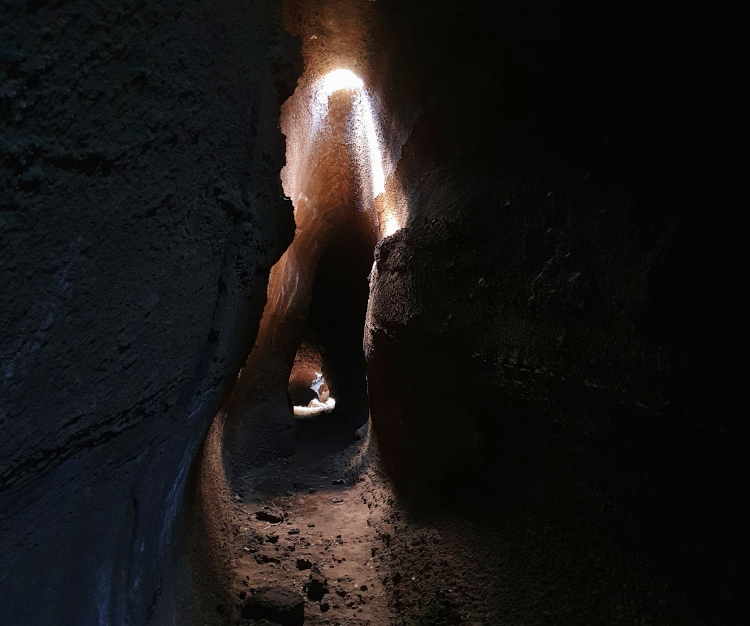Or: Why the Catanese invented ice cream.
If you follow our blog closely, you already know how lava tunnels are created during a volcanic eruption. This time we want to tell you something about what it looks like inside these caves and what special things have already happened in some caves.
Geological peculiarities
Let’s start at the end of the volcanic eruption: no more new lava is coming in, the tunnel formed by the lava flow is slowly beginning to empty. The still hot lava drips from the ceiling of the tunnel and begins to solidify. The formations that are created on the ceiling in this way are pulled further by the flowing lava and thus take on the shape of dogs’ teeth (denti di cane). If you take a tour of Mount Etna, don’t miss this unique phenomenon!
The gas in the lava also causes bubbles to form on the walls, which eventually burst open (blisters). The edges of these bubbles can still be seen in the grottos.
The cave is now completely empty, but the walls are still hot and it takes about a year for it to cool down. Then the “spring” begins in the lava grotto: due to the humidity in the cave, substances such as calcium carbonate dissolve from the rock and form small crystals on the walls. However, this splendour is not permanent, after a few months the moisture dissolves these fragile flowers again.
The caves are also very different in other respects: the walls are sometimes smooth like glass, then again rough and uneven. Sometimes the ceiling is metres above the visitors’ heads, sometimes you have to crawl on all fours.
By the way, there are no stalactites and stalagmites in the lava tunnels of Etna! The lava contains too little calcium for the creation of these formations.
A tour to the Cave Serracozzo
Probably the most beautiful lava tunnel is the Grotta di Serracozzo on the north side of Etna, which can be reached in a short hike from the Citelli refuge (see Etna Trekking Tour). A few metres after the entrance, the light shines in through an opening in the ceiling and illuminates part of the cave (skylight). Depending on the position of the sun, this results in beautiful plays of light.

Furthermore, if you have already climbed to the cave, you can continue the tour to the Valle del Bove (ox valley), marvel at this vast valley and then descend again (on the descent you can see the eruption and the craters of 1928).
Mount Etna as a fridge
It is always cooler in the lava tunnels than on the surface, even in summer it does not get warmer here, underground. Therefore, when snow falls in the grottoes, it sometimes remains over the summer, if properly covered and preserved. In the Grotta del Gelo (Grotto of the Cold), for example, a small glacier formed from 1624 onwards, making it the southernmost glacier in Europe. Unfortunately, this is at great risk due to the rising temperatures and also because the opening in the ceiling has increased, allowing more warm air in and melting more and more ice. So it has become smaller and smaller in recent years.
A few centuries ago, when there were no refrigerators, snow was stored in many caves in winter. The snow was compressed and the rain and moisture froze the snow into ice. Covered with a layer of volcanic sand, the ice was stored all year round. At that time, Etna’s merchants gave their customers a guarantee that they would be supplied with ice from spring until the following December. A sensation that was unimaginable in the rest of the Mediterranean!
For sale, the ice was cut into blocks, wrapped in fern leaves and packed in hemp sacks, transported away and sold all over Sicily. From the ports of Catania and Riposto (also called “the port of Etna”), the ice, a luxury good in those days, was even exported to Malta.
At first, the ice was only used as a coolant. The people of Catania then had the idea of mixing ice with honey and lemon juice and thus making the first granita one of Etna’s treasures.
You should definitely try this Sicilian ice-cream speciality (after an excursion to Mount Etna, you really deserve it!).
Even today, the granita is made only with ice cream and fruit; it is eaten together with a brioche. In Catania, they also say that the chef who prepared the first ice cream in Paris is originally from Sicily… So who knows, maybe Etna is the origin of this refreshing delicacy!
Robber’s Cave (Grotta dei Ladroni)
Where the Grotta dei Ladroni (Robbers’ Cave) gets its name is probably obvious to everyone right away. The story goes that it belonged to a gang of 4 robbers in the 18th century. served as a shelter. The underground cave has two entrances and exits: on one side a large ramp led down, and the robbers are said to have ridden into the cave with their horses and mules. On the other side, a narrow staircase, the steps carved into the stone, leads out again. The robbers are said to have escaped from their pursuers via this second exit. Despite this good hiding place, however, the gang’s raids were not very successful, as the story goes in the villages of Etna.

These were just a few examples of the things that have happened and are happening beneath the surface of Etna. If you want to discover more, you’ll have to do a hike up Etna and to the lava tubes yourself – or better with us ???? !

